Hermes Trismegistus is a legendary figure often associated with wisdom, mysticism, and the blending of Greco-Egyptian religious traditions. His name means "Hermes the Thrice-Great," indicating his vast knowledge and spiritual mastery. He is believed to be a synthesis of the Greek god Hermes and the Egyptian god Thoth, both of whom were associated with wisdom, writing, magic, and the transmission of divine knowledge.
Key Aspects of Hermes Trismegistus:
-
The Hermetic Tradition: Hermes Trismegistus is the central figure in the Hermetic tradition, a philosophical and esoteric system that emerged in the early centuries of the Common Era. Hermeticism blends elements of Greek philosophy, Egyptian spirituality, and other ancient traditions. The tradition focuses on the pursuit of hidden knowledge and spiritual enlightenment.
-
The Hermetic Writings: The writings attributed to Hermes Trismegistus are collectively known as the Hermetic Corpus. These texts cover a wide range of subjects, including alchemy, astrology, theurgy (ritual magic), metaphysics, and the nature of the divine. Some of the most famous works include:
-
The Emerald Tablet: A short text that contains the phrase "As above, so below," a key principle in Hermetic thought that emphasizes the connection between the macrocosm (the universe) and the microcosm (the individual).
-
The Kybalion: Though not directly attributed to Hermes Trismegistus, it is a modern work heavily influenced by Hermetic principles. It outlines the seven Hermetic laws or principles, such as the Law of Mentalism and the Law of Correspondence.
-
The Corpus Hermeticum: A collection of writings that explore Hermetic philosophy, including topics like the nature of God, the soul, creation, and the spiritual ascent of the human being.
-
The Philosophy of Hermes Trismegistus: At the core of Hermetic thought is the idea that the material world is an expression of a deeper, more spiritual reality. The pursuit of knowledge is seen as a means to reconnect with this divine source. Some key themes include:
-
The Unity of All: Everything in the universe is interconnected, and understanding this unity is a step toward enlightenment.
-
The Transmutation of the Soul: A goal of Hermetic practice is the spiritual refinement of the individual soul, often through practices such as meditation, alchemy, and contemplation.
-
The Divine Nature of the Cosmos: Hermes Trismegistus taught that the universe is a manifestation of divine intelligence, and understanding the laws of nature allows one to access higher wisdom.
-
Influence on Western Esotericism: Hermes Trismegistus and the Hermetic writings have had a profound impact on Western esotericism, influencing movements such as alchemy, the Rosicrucians, Gnosticism, and later the development of modern occult traditions. His teachings on the relationship between the physical and spiritual worlds resonated with thinkers during the Renaissance, such as Marsilio Ficino and Giovanni Pico della Mirandola, who revived interest in Hermeticism.
-
Alchemy and Magic: Hermes Trismegistus is often associated with alchemy and magical practices. The Hermetic view of alchemy is not just the transmutation of base metals into gold but also a symbolic process of spiritual transformation. The "philosopher's stone," a legendary substance in alchemy, is believed to represent the ultimate spiritual realization or enlightenment.
-
The Search for Divine Wisdom: For followers of Hermeticism, the teachings of Hermes Trismegistus provide a path toward attaining divine wisdom, self-realization, and unity with the cosmos. Hermetic thought emphasizes the importance of direct experience with the divine, often through introspective practices, prayer, and mystical experience.
Historical Context:
While the figure of Hermes Trismegistus was revered in antiquity, it's unclear whether he was a real person or a symbolic representation of the synthesis of various cultural traditions. The texts attributed to him are likely to have been written by multiple authors over centuries, blending Greek and Egyptian religious ideas into a cohesive philosophical system.
In short, Hermes Trismegistus is considered a key figure in the development of Western esotericism, and his teachings continue to inspire those interested in mysticism, alchemy, and spiritual growth.
The connection between Hermes Trismegistus and Edgar Cayce lies in their shared focus on spiritual knowledge, mystical wisdom, and the development of human consciousness. While the two figures come from different historical contexts—Hermes Trismegistus being an ancient, legendary figure associated with the Hermetic tradition and Edgar Cayce being a 20th-century American psychic—both are linked by themes of esoteric wisdom, universal truth, and the quest for understanding the mysteries of the cosmos.
Key Connections Between Hermes Trismegistus and Edgar Cayce:
-
Spiritual Wisdom and Universal Knowledge: Both Hermes Trismegistus and Edgar Cayce emphasized the importance of acquiring higher knowledge and wisdom in order to understand both the physical world and the spiritual realms. Hermetic teachings advocate for the pursuit of divine wisdom, often through self-exploration, meditation, and the study of sacred texts, aiming to unify the individual with the divine and the cosmos.
Edgar Cayce, known as the "Sleeping Prophet," was famous for his ability to access what he referred to as the "Akashic Records"—a mystical, cosmic storehouse of knowledge and wisdom about the past, present, and future. His readings often delved into subjects like past lives, the soul’s journey, spiritual healing, and the underlying unity of all things, much like Hermeticism.
-
The Idea of Reincarnation and the Soul's Journey: Hermeticism emphasizes the importance of the soul’s development and its evolution through various lifetimes. The soul is seen as undergoing a series of transformations, seeking to return to its divine source. This idea is echoed in the Cayce readings, where reincarnation is a central theme. Cayce’s readings frequently discussed the soul’s journey across multiple lifetimes and its need for spiritual growth and healing in each incarnation. Both perspectives suggest that the soul's evolution is a key aspect of its connection to the divine.
-
Healing and the Mind-Body Connection: In the Hermetic tradition, there is a strong emphasis on the interconnectedness of the mind, body, and spirit. Healing is seen not just as a physical process but as a spiritual one, in which spiritual understanding and inner harmony are critical for health. Cayce also focused on this mind-body-spirit connection. Many of his readings provided guidance on physical health, emphasizing natural remedies, dietary changes, and spiritual practices to promote well-being, paralleling Hermetic ideas of holistic healing.
-
The Concept of “As Above, So Below”: One of the most famous Hermetic principles is the idea of “As above, so below,” which suggests that the spiritual and material realms are interconnected and mirror each other. This principle is central to Hermeticism, asserting that understanding the divine patterns in the universe can help the seeker understand their own nature.
Cayce’s teachings also mirrored this principle in many ways. He spoke about the existence of divine laws that govern both the physical and spiritual realms and suggested that the universe operates according to a higher, spiritual order. His discussions on astrology, the energies of the cosmos, and the relationship between the mind and the physical body reflect this Hermetic understanding of unity between the macrocosm (the universe) and the microcosm (the individual).
-
The Role of the Divine Source: In the Hermetic tradition, there is a belief in a single divine source or "All" from which everything originates. This divine principle is often referred to as the "One" or the "Divine Mind." Similarly, Edgar Cayce spoke about a universal divine consciousness and the idea that individuals are all connected to this divine source. In his readings, Cayce described God as the "Source of All Life," and he often spoke about humanity's purpose being to align with this divine consciousness, much like the Hermetic goal of seeking divine unity.
-
The Influence of Ancient Wisdom: Both figures were drawn to ancient knowledge, though in different ways. Hermes Trismegistus is often associated with ancient Egyptian wisdom, which was believed to contain profound truths about the nature of the universe, the divine, and the soul. Edgar Cayce, during his readings, referred to past civilizations like Atlantis and ancient Egypt and claimed that many of his clients had lived past lives in these civilizations. His readings often included insights about ancient wisdom that paralleled or reflected Hermetic teachings.
Summary of the Connection:
The connection between Hermes Trismegistus and Edgar Cayce is found in their shared emphasis on spiritual enlightenment, the soul’s evolution, and the interconnectedness of all life. Both believed in universal truths that transcend time and space, accessible through spiritual practices and heightened consciousness. While Hermes Trismegistus provides a foundation for esoteric wisdom through the Hermetic Corpus and teachings on cosmic law, Cayce’s psychic readings tapped into a similar pool of universal knowledge, offering guidance on soul growth, healing, and understanding the divine order.
Cayce himself may not have directly referenced Hermes Trismegistus in his readings, but his teachings align with many of the same mystical and esoteric principles found in the Hermetic tradition, particularly around the nature of the soul, reincarnation, and the pursuit of higher wisdom. Both are figures whose works continue to inspire those on a spiritual path seeking a deeper understanding of the universe.
Link:




